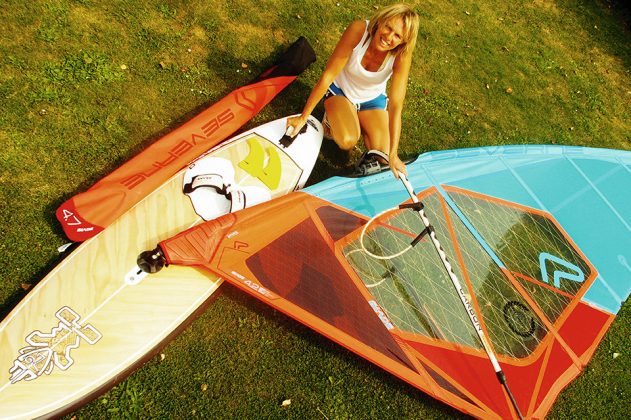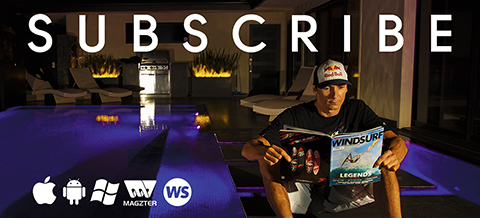SMALL BUT PERFECTLY INFORMED
Words Peter Hart // Photos Hart Photography
Originally published within the October ’16 edition.
Last summer, Harty isolated the plight of the heavier windsurfer. This month he redresses the balance and tackles the issues faced by the featherweights – if there are any …
On the final day of a wave event in Australia, the race officer sent us out for a heat in 10 knots of wind. I was 88kg. My rival was 65 kg. Whilst he floated out with dry heels and then ripped and slashed at will, I spent most of the heat with my fin touching the reef and the water lapping around my upper thighs. Back on the beach and with no sign of an abandonment flag, I approached the head judging honcho, a Californian dude, and quizzed him on how that could possibly have been fair. “Man … you just gotta know what equipment works with your body and dial in to the rhythms of the ocean … (pause as he draws on a huge reefer)”
“Well given the wind you sent us out in, the gear that works with my body would have to be 180 litres and a spinnaker!”
“Well use that then man …” This was 1988 and I pointed out to ‘dudey’ that there were no wave boards bigger than 85 litres – and even if there were, they wouldn’t fit on the wave face. It was stacked in favour of the little guy. Upon which he shrugged and walked off. It was his job to get the contest done and dusted and there was no way a lardy Brit was going to ruin his day.
Midget envy
For a while after that I had deep midget envy. The light guys seemed to have an advantage in every discipline. The grievance contained an element of truth. The pro racing wind minimums were pretty low (11 knots) and the biggest sail that worked efficiently on all points in that era was about a 7.0. However, my protest was mostly self-fulfilling. When you decide you’re going to fail at something – marginal wind sailing in this case – you usually do … and so I did. As it happens, our best wave sailor of the era, in all winds, was 6’ 4” Duncan Coombes; and our most successful course racer (although not a dedicated fan of light winds) was a distinctly chubby Mark Wood.
Most competitors view all issues through self-obsessed eyes and it wasn’t until I took up coaching that I became sympathetic to those at the other end of the scales. I realised that small, light people had their own problems. They were not so well served by an industry, which made kit for the average sized human, and often struggled to take up the shapes and sail in the way that the manual demanded.
Because I am on the big side of average, I have no right to pontificate in absolute fashion about the woes of the small, so while I offer general observations on kit and technique, I have canvassed opinion from various light people, pros and ams. They reveal what hurdles they have faced and how they’ve leapt over them. But as you will notice, all of them eventually rejoiced in their lack of kilos.
How small is small? ‘Small’ in an adult windsurfing capacity is about 60 kg and under. But it’s not just about weight. Height (lack of it) and limb length ARE yet more influential. A 60kg 6 footer would have few problems apart from having spaghetti limbs that would be liable to snap. Adults around five foot and less can struggle with certain aspects of certain sail designs – e.g. the height of the boom cut-out and the positions of the clew and the centre of effort, all of which can be way over their head. And note we’re not talking about kids. They’re a topic apart. They have their own specialist kit, besides which they grow, so any problems with size tend not to last long.
“ Light people all too often end up on over-sized heavy kit, which convinces them that windsurfing
is a strength sport and puts them mentally on the back foot ”
Early Issues
Everything that’s good and bad stems from equipment choice and set-up. It’s the same for all sizes, except that those at the extreme ends are more likely to be on the wrong stuff. Throughout the levels it’s essential to recognise the symptoms of bad kit and tuning. In this instance it’s fine to blame your tools. Let’s start with the basics.
“ If you’re light and constantly on a board with too much volume, you don’t get to develop and exploit your natural advantage,
which is your light-footed agility. ”
Case 1 John Smith
John is 60 kg, 5’5” and a fascinating case. He’s very proficient in all winds and seas and has developed a style entirely around his shape and size. Some may remember he was the subject of a ‘set-up’ article some years ago. I challenged his use of tiny 20” lines, a chest high boom and outboard straps on his wave board, until he pointed out that he has unusually short legs (his nickname is ‘Hobbit’) and if he uses long lines and a high boom, his legs don’t reach the board! He does have a classic, ‘sit on the tail,’ 80’s strap to strap gybing style. On clinics I try to change him and get him on a smaller board, without much luck. It could be a case of “if it ain’t broke, don’t fix it.”
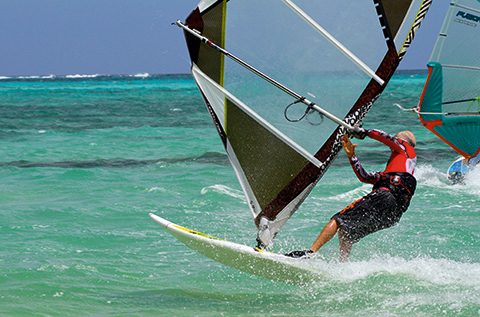
John Smith enjoying the light man’s privilege of being able to gybe from the tail and remain in the straps as he flips the rig without sinking. PHOTO Hart Photography
“By and large I think the standard kit works for most people. I do wonder if a less stiff mast would be better, I often watch the rig of bigger sailors twisting off nicely whereas mine just seems to hang there limply not doing an awful lot. Also the trend of wide boards is good in most conditions, but if it’s a force 6 or 7 with choppy conditions I struggle to keep them on the water and will always use a narrow tailed thin board below 70 litres. Lightweight rigs to me are very important as we don’t have the leverage to pull big rigs around. Also I like a sail with all the drive at the front and don’t need or like a backhanded grunty sail. I probably use a bit more than the recommended downhaul when powered up, again maybe because masts are relatively stiff for my weight. Same with outhaul as the wind increases. I sail with quite a few small blokes. The one mistake I think they make is using a fin that’s unnecessarily large too.
Fins can make a big difference. Going small with a nice flexi tip seems to work for me. Most of the time I think it’s a pretty big advantage being light, I know you have said I get away with murder on the gybes! Being able to sail on smaller kit and keeping planing through lulls can drive my heavier mates crazy. I think also as you have said in previous articles, some people sail heavy whatever their weight and others are light footed. Being proactive, and not a passenger makes as much difference as weight.
0THE STANCE – passive aggressive
Many small people look like they’re just hanging on and getting pulled along. The rig is tilted too far to windward over their head. They’re hunched down well below the boom but despite the effort, they’re sheeted out, the nose is riding high, a rooster tail is spurting off the back of the board; they’re not fully released onto the plane and their back foot is mostly out of the strap.
So breaking it down …
Rig canted over too far to windward
The primary reason is too high a boom. Sorry for stating the obvious but you have to choose a sail that has a cut-out low enough to allow you to sail with a shoulder high boom. But help yourself get the boom lower by adjusting the mast extension so there’s the smallest gap between the foot of the sail and the deck.
However, it’s often not boom height but the high placement of the centre of effort. In most all-round sails, the sails CE is around eye height of an average person, so the smaller sailor feels that they’re always pulling down against the power.
Looking at them head on, it looks like a constant tug o’ war with a lot of windward leeward rig movement – they pull down, the rig pulls them back up – which in turn disrupts the board trim.
There’s no easy answer here apart from to try different designs. For example some of the latest 3 and 4 batten wave sails have a lower CE to compliment the latest low boom, compact, surfing style.
Case 2 Richard McKeating
Richard, alias ‘tricky Dicky’ is super light (58 kg) but average height. The ‘tricky’ moniker is earned from him spending much time at Brogborough lake sailing every which way but normally. When I mention in the article ‘relying too much on the volume’, I had him in mind. But by making smart kit choices and shedding many litres I have seen him on clinics progress from flat water twiddler to highly proficient wave sailor.
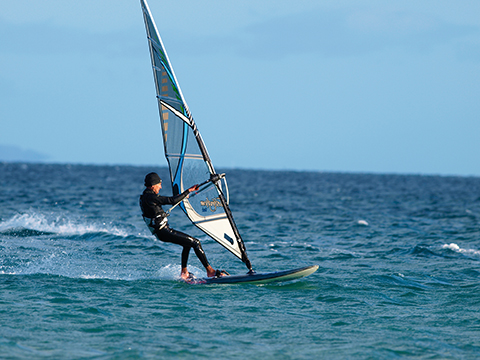
Richard loves his lightness. Having grown up relying a little too much on the volume, this 94L is now his go-to light/marginal wind, muck-about board. PHOTO Hart Photography
I go soft. E.g. I rig my 5.7 on a 400 and a 4.7 on 370 with lots of floppage. People are generally surprised that I am still hanging on in a blow despite my feeble form. I opt for super light carbon everything.
I heeded your advice to go smaller on the boards (it’s never a good sign when you can stand with both feet somewhere behind the rear footstrap without the board moving from the horizontal). I’m happy now with my 69, 77 and enormous air-craft-carrier-light-wind Kode 94 and a 120 slalom (which is like Formula for me). Is it an advantage to be light? I feel like the luckiest guy in the world when I am the only one planing (although this makes me unpopular! I believe your name for it is ‘cheating’). I have hardly ever broken any kit whereas my big mates tend to explode everything they touch (I just break me! DISADVANTAGE – lack of padding!! – Get a good impact vest)”
Sheeted out.
Yes harness lines may be too far forward and there may be a slight lack of commitment. However that lack of commitment is usually down to the rig producing a hard, over-powering type of power. A typical situation is that someone learning to plane has borrowed a small sail of a larger peer. Because high winds are relatively rare, they’ve skimped on the hardware and this 4.7 is setting on a 430cm mast with about half a metre of bare mast sticking out of the top. That half metre is extra weight and drag. It makes the sail feel top heavy. Mostcrucially, it means the sail is setting on the stiffest section; which in turn means it can’t twist and self trim. As the smaller person tries to sheet in, the leech stays closed and the rig seems to fight back.
The treatment is to set the sail on the shortest, softest recommended mast. On a softer mast the sail can breathe. You’ll have a wider sheeting angle, meaning your back hand is met with less resistance. And as you pull in, the power comes on more slowly and then softens as you accelerate. There may also be a harness issue. If you are pulling down against the power the default waist harness gets lifted up over your ribs. It’s not only uncomfortable, but the higher the hook rises, the less power you naturally transmit through your legs into the board. It’s controversial but shorter people often do a lot better in a seat harness.
Not fully on the plane, nose high.
It’s all related to the above. If you can’t sheet in properly, you can’t deliver enough power to the mastfoot to hold the nose down and get the tail to release. It may also have a lot to do with the board and rig match. Smaller people are often on relatively big boards (this will be a common theme) and are using rigs that are at the bottom end of, or even below the recommended range for that volume, and which don’t have the weight and power to hold the nose down.
Back foot out of the strap
It could also be down to a lack of speed but just as likely down to footstrap spacings set for a long legged person and too wide apart – putting the back foot in forces you to do the splits. Set the front straps back and the back straps forward to narrow the gap.
POOR SPEED – surely a size issue?
Well it’s written in stone isn’t it? ‘Fat is fast.’ Lets start by exploding a few myths.
“Little people are faster in marginal/moderate winds.” Wrong. They may plane earlier but ironically big folk have more of an advantage in medium winds because they have the leverage to pin down a monster rig.
“Little people are obviously going to struggle when it really blows.”
Even wronger. When I was competing, the most devastatingly quick guy on the speed course when it got crazy windy and gnarly was Eduardo Bellini, who was 20 kg lighter than the iconic speedsters of the time. In those conditions skill, agility, lightening reflexes and delicate, fast-twitch feet are infinitely more effective than blubber. However, your kit has to allow you to be skilful. You can’t be anything but defensive on a board which is trying to buck you out of the water or a rig which is wrenching your tendons.
Here’s the rub – if some big guys are faster, it’s because they’re on relatively much smaller boards than their smaller peers.
“ I don’t mean this to sound harsh but it’s easy for lighter windsurfers to be a little lazy with regards to volume. Most boards are pretty big for them so they learn to rely on that volume for the basic tasks (like getting planing). But that extra volume can really work against them as they take
it up a level ”
SMALL FOLK RIGGING TIPS
• Dead weight is a killer. It makes everything – uphauling, waterstarting and power control harder. So go for high carbon everything, mast, extension and boom if you’re feeling flush (mast being the most important). Yes it’s pricey but a light, well-tuned small rig has a far greater wind range so you won’t need as many.
• Use the shortest, most flexible recommended mast. If it says ‘recommended IMCS 16-19’ go for 16 (370cm) with the longer mast extension. The softer mast allows the sail to breathe, gives it a wider sheeting angle, makes it softer, less twitchy and easier to pump.
The saddest sight is a light person with a metre of bare mast sticking out the top of the sail. That length of bare pole is heavy and increases windage and drag. It sticks to the water when waterstarting and uphauling. It also means the sail is setting on the stiffest section; which in turn means it can’t twist and self trim and makes it feel over-powering and yet heavier.
• Don’t pull the guts out of it! The constant fear of being over-powered can persuade small people to rig defensively. Take a 4.7. It may be a small sail for a big person … but it’s a big sail for a small person. Yes you need plenty of downhaul but leave some shape in it.
Keep the centre of effort low by rigging the sail as low to the deck as possible.
Go narrow! RDM masts and narrow gauge booms are not necessarily lighter but they feel lighter, and are much easier to grip.
Board size – from a virtue to a vice
A small person learning to plane has a terrific time. Take a 60 kg sailor in 14 knots of wind (force 4) using a 5.7 on a 110 freemove board. They have 50 litres of reserve volume and much of it under their feet.
(A litre supports 1kg – so ‘reserve’ volume is the board’s volume minus your weight. In this case 110-60=50L).
So off the plane, they can step straight into the straps without sinking and just sheet in gently and get blown onto the plane. Instant joy … however, if there’s enough volume under the straps to support them off the plane, when they get going properly and the board and fin start to lift, they soon find they haven’t enough weight to hold it down. As it bounces, they have no choice other than to back off the power.
To reach a competitive top speed and have control in chop, you want a board and fin that become more directionally stable the faster you go. That encourages you to bear away and accelerate rather than back off – but that usually means starting a little under water.
Speed and the smaller windsurfer, at the top end, is a massive subject but it’s all about scaling back, reducing drag and increasing efficiency. 70 kg Taty Frans has been scoring top 10 honours in slalom, a game dominated by 100 kg hunks. He’ll often be on a sail 2 sq. m less – but on a board and fin to match. But for a lot of smaller guys, that reduction in volume is an unwelcome introduction …
“ Simon Bassett of 2XS encourages small people to learn to plane without footstraps so they get a feeling for
longitudinal trim and how the board sticks or releases as you move back and forward. ”
Volume perception and early planing
General interpretation of volume as understood by the average adult is as follows.
150 litres + = big
100 – 140 = medium
Sub 100 = small
The problem is that when a 60 kg turns up on a clinic with a 100 litre board, they already think they’re on a small board; and when I tell them that by the end of the week, I want them on a 75, they look at me as if I were an axe murderer. A 75L is surely dangerously tiny?
It isn’t. For them, it’s a planing allrounder. It’s like me (88kg) using a 100L.
Of course there is a skill factor. But a lot of small sailors don’t develop those balance and trim skills because they don’t have to. Some actually get very good at controlling big boards (for their weight) but shy away from going small because suddenly they’re not scooting away before all the fatties and they feel their one big advantage has been stolen from them.
The techniques missing from the armoury are trimming and balancing on a board that is riding low in the water; and the ability to ‘bump’ a board up onto the plane. That is to say getting it to rise up from under water and over-take its own bow wave. It’s achieved by co-ordinating all the lift devices – bearing away, pumping and driving and releasing the nose.
The advice to ambitious small people is the same Dave White gave to big fellas in the June issue, (who have no choice but to sail relatively small boards). Go out on that small board (70 – 80 litres for the small guy) in fluffy winds. Work out where to stand, sail it off the plane, tack it and uphaul it. With a little practice a 60 kg sailor can easily uphaul a 75 litre board. And with that skill, re-adjust the volume table.
120 litres = HUGE. Plenty of volume off the plane for messing around and the biggest you’ll need for earliest planing with a big sail (7.5 ish).
85-100 = allround, easy medium wind planing.
70 and under = small … But not that small. There aren’t many boards out there that sink under the weight of a 60 kg windsurfer.
“ I could save you a lot of time and just say, “little guys … just get used to sailing smaller boards! ”
Case 3 Ronnie Sommerville
60 kg and about 5’ 6” Ronnie has a house on Tiree so is well used to handling whatever bombs Mother Nature has to offer. Completely unfazed by storms, he also enjoys a marginal wind free-ride blast and he has a 13 year old son Ruaraidh who is mad for it. As a result he’s packing a lot of equipment. He’s a big thinker/analyst is Ronnie, and while he seems to have his quiver well sorted, he reckons more could be done for the lightweight in terms of information.
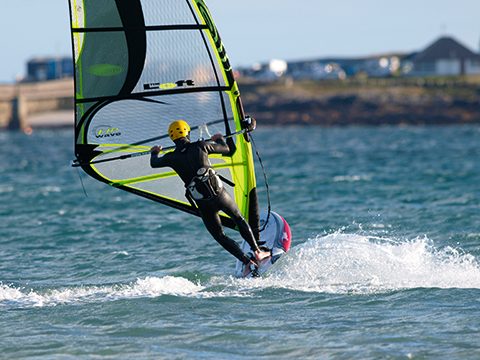
Ronnie loving the lack of kilos. PHOTO Hart Photography
“There seems to be poor communication of what kit is “better” eg does a particular sail suit lighter people? Have sailed some sails on holiday that seem definitely NOT made for lighties, they just felt like pigs. I think it helps to look at the size of the team rider. It would be great if the magazine reviews had 65kg testers. Rigging for my son has made me think a lot about “sail size” versus weight, how to do the maths? It’s not a straight percentage because little sails are less efficient and when it gets windy everyone is on more or less the same. Is being a lightweight an advantage? Yes girls prefer lighties…and planing before the other guys is always nice. Unless you do speed I can’t see any advantage in being big.
Carving
Thanks once again to a relatively big board, small people enjoy a massive advantage learning to carve gybe and progressing to the stage where they’re planing out of them.
• They plane at slower speeds so can attack initially with less trepidation.
• The rails don’t sink as deep so there’s less chance of stalling.
• The board floats higher and carries its speed absorbing many errors of trim.
• At the end of the gybe, as they change feet and rig, even if they get caught in the back seat, they tend not to sink and over-rotate.
When it comes to planing out, many employ the original strap to strap gybe. They leave their front foot in the strap all the way round, release the rig early and even as the board carves round with the rig depowered, they can stand on the tail without it sinking. It’s a practice which infuriates the heavyweights who would sink six feet below the waves if they tried such a stunt.
However, like early planing, if they learn to rely too much on that volume, the next stage eludes them. The next stage in carving is being able to manipulate the shape of the turn, bank more steeply and slice through chop; which comes from leaning forward engaging the whole length of rail and then having the power/weight to hold that rail in the water at speed.
The smaller guy on the bigger board discovers the rails at the front are too thick. If he engages them they either trip or bounce out. So they develop a back foot style where they lean back and gybe off the tail when the rails are thinner. The remedy? You’ve got it – reduce the volume to a board with thinner edges and change the gybing style. That means:
• Relying less on board momentum to carry you round, and making better use of rig power.
• Thinking of the mastfoot as an extra foot of your body, powering down through it as you carve and using it to engage the nose section.
• Working on the step gybe (changing feet and stepping forward before the rig flip) as a means to level the board off and control the nose of a smaller board at the end of a tight gybe.
• DON’T BE LAZY!
Case 4 Bill Godfrey
Bill, the lightest of the bunch at 57 kg, has been sailing since 1980, is hugely experienced and is delighted someone has finally addressed this subject!
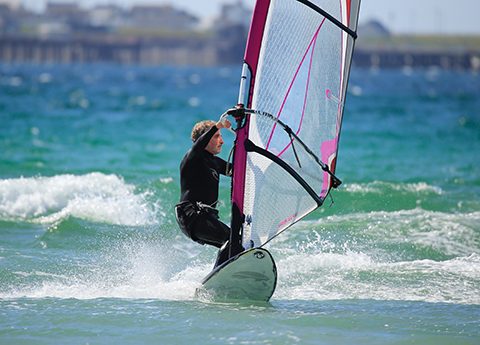
Bill, 57kg, on his 66L twin in 18 knots of breeze – it’s pretty much the only board he needs. Note he’s wearing a seat harness – often a good option for short people pulling down against the centre of effort. PHOTO John ‘Tufty’ Cambell
“Kit choice is much better than in the past. For years I had to use customs because production boards were never small enough. Multi fins have made a great difference; my 66 twin is just about perfect for me. I used it on Sunday in 18-40 knots cross off, small waves with a 3.5. I was overpowered but not out of control – and then again on Monday in 18 knots. It gets through the lulls no problem and turns better than I can. I’ve found that I can minimise my kit – the biggest wave sail I need is 4.7 – I had a 5.4 but never used it. Likewise with my wave boards – as well as the 66 I have a 75L single thruster for float and ride – but I don’t really need it. My fins are also much smaller than most people. Steve Thorpe of K4 was a great help choosing my fins. I’d say it’s a massive advantage being light. I can plane before most people. My biggest board for free-riding is a 100L with a 6.0 and last Sunday I was planing earlier and was as fast as a UKWA slalom racer on 8.6 & 110L slalom kit … until the wind really got up.
RELATIVELY HUGE
Big John Issit, hero of June’s big man article, stands alongside Little John Smith. Big John is 55kg heavier but on a board only 40L bigger. Lightweights have the glorious option of sailing relatively bigger boards and getting away with it.
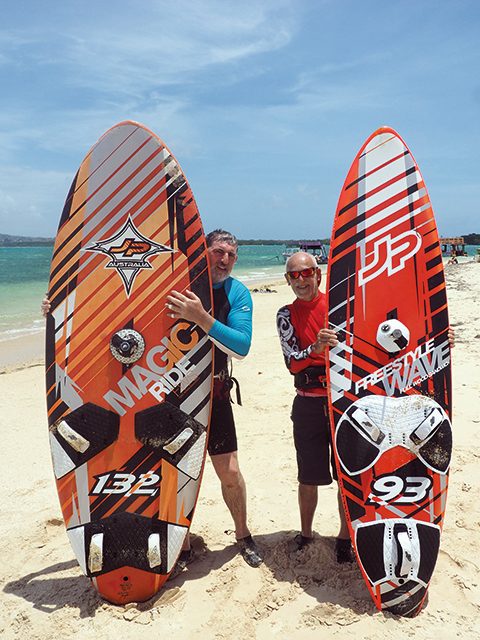
Big and Little John. The bare truth is that smaller windsurfers enjoy many benefits but only if they choose and tune the kit smartly.
Into the waves
Life is great for all sizes of wave rider these days because big multi fin boards are so much more controllable than shapes of yore. Little guys appear at an advantage because it’s easier for them to squeak out on light wind riding days, survive the lulls and pop on the plane earlier to get those inside jumps. But when it comes to riding, the message is the same.
In Jeri (Brazil) a guy asked for tips as to how he could inject some ‘vavoom’ into his rides. The fact that we were on the same size boards (90 litres) despite him being 25 kg lighter, could have had something to do with it. The thick rails locked him into long turns. Wave riders are appraised on how deeply they gouge; how many degrees they turn through, how vertically they approach the lip and how much speed they carry.
The only way Ben could steepen his turns was to lean back and stamp on the tail, which not only killed speed but often made him drop off the back of the wave.
Wave riding at full tilt, you should be able to roll over onto the rail and feel it bite and yield. If you feel it fighting back and corking to the surface, it’s time to lose some litres.
Getting boards under control through the turns also has a lot to do with set up. Try shortening the rail by setting the front straps as far back as they’ll go. Stiff fins can offer too much drive to the small person and lock them into long arcs – so experiment with smaller, softer fin(s).
And let us not ignore the influence of designs. A small board for a big and small person could be very different in terms of rocker and everything.
Small sailors should align themselves with a small shaper who is fully empathetic to their lot.
Don’t be spooked by the thought of the smallest board on the market. Let me leave you with an anecdote. Sailing back from Manawa, a wave break about a mile off the SW coast of Mauritius, I heard a shriek behind me. It was my 58 kg wife.
“Are you OK?”
“Help! My feet are getting wet – what do I do?!”
The wind had dropped down to about 10 knots and we were schlogging back off the plane. I can’t remember exactly what I said but here’s the gist.
“You’re on your micro 66 litre wave board in a force 3 and your toes are getting a bit damp? Welcome to my world …” I (88 kg) said through clenched teeth as my 86 Quad disappeared from view and I reached for the snorkel.
Light people – you don’t know how good you’ve got it!
Case 5 Mandy Parke
I didn’t ask Mandy’s weight – not because I was being gallant, she’d have told me. I just forgot. But I’m estimating she’s around 60 kgs and about 5’5”. She’s a committed free-rider. She’s recently become a personal trainer and so by definition become super fit, which she backs up with mental fortitude. She’s incredibly determined and craves speed and loves a bit of power. The following chat took place in Rhodes after a week’s clinic in 13-22 knots of wind.
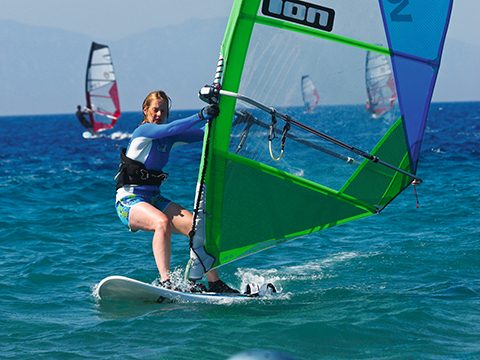
Narrow gauge booms and skinny masts made a huge difference to Mandy’s sailing. PHOTO Hart Photography
“I realised that just going bigger on the volume didn’t help early planing. On the marginal day I found the 120L with a 6.4 released earlier than the 130L with a 7.2. It was the same when it got windier – with my weight I planed earlier on the 86L than the 96L. It just felt lighter. Last year I changed to a narrow boom – instant epiphany. You don’t have to grip as hard – just hang the fingers over. It’s so much more relaxing. Release the grip and your whole upper body relaxes. I also went for skinny masts – they felt lighter and I could grab them more easily in the tacks.
I’m already light but I trained and lost more weight and got fitter and stronger. What a huge difference. Strength is probably more important than weight. Everything, like waterstarting big sails, became easier.
Case 6 Thomas Traversa
Thomas conclusively should be the featherweight’s guru. Weighing just 60kg he is one of the best, if not THE best strong wind sailor in the world, having won the iconic Red Bull Strom Chase event. The recent World Cup event in Pozo saw him continue in similar vein as he sailed with extraordinary style and dynamism in winds well over 50 knots. So I asked him what kit he was using on that day and how he tuned it.
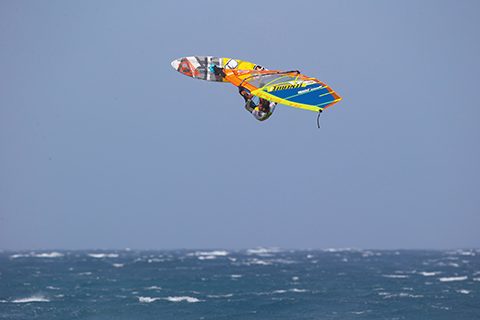
Thomas flying in 50 knots. It’s all about the kit and the tuning … along with huge balls, years of practice and a massive dollop of innate talent. PHOTO (Carter/PWA)
“I used the 3.3 Manic rigged on a 340 mast to stay soft. When it is super strong I like to rig it with quite a lot of down-haul, but nothing too extreme either, because it is already a small sail and I don’t want to end up riding something that feels like a 2.5m! I prefer to really put on a lot of outhaul tension for the sail to be light in the hands and easy to move, even in stormy winds. This also helps me hold on when going through big gusts. Obviously this only works if the wind is consistent and the waves not too big/current not too strong. With a lully wind or big waves/current I need to keep a bit of power in the outhaul to be able to accelerate fast and keep speed through wind holes. But we all know Pozo is not really famous for big waves hahah!! This tip probably only works for smaller riders. I guess that a heavier guy using a 3.3 has to keep some outhaul power no matter how strong the wind is, if not he will have a hard time to plane even in 50knots +. The board I use is a 63L, which is the same as my medium board (68L) but 1.5 cm narrower (53cm). I don’t like to ride wide boards in strong wind, I feel like I fly too much and can’t really control my gear. With a narrow board I can use the rail even if I am super overpowered, and I have more control going straight, so in the end I can go faster and jump higher. Fins – I use the same as always : thruster 14/10 if waves are small and 15/10 if waves are bigger.”
Harty will be writing his next piece from the glorious shores of Donegal, where he will advise you on how best to make that scary journey from
sheltered water to open ocean – and maybe even towards a wave or two. Check out his ever popular clinic schedule on www.peter-hart.com


